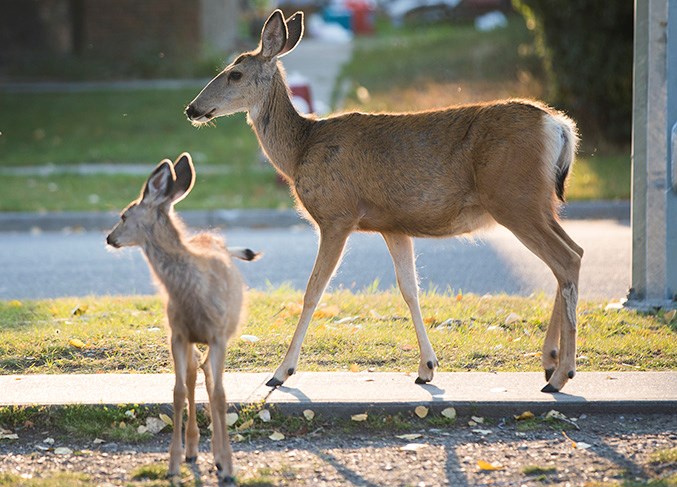Okotoks is looking for help to identify its strategy with urban deer. Ahead of the Town’s second deer count, which took place Sept. 14 and Sept. 16, Okotoks councillors heard from parks manager Christa Michailuck as to possible options for handling the ungulate – or deer – population in town. The first step will be to educate the public and try to change behaviours of Okotoks residents, she said. “There’s a lot we can be doing before we ever entertain deer control measures, especially these days, you’ll see crabapples from the trees are on the ground,” said Michailuck. “Until we clean up all that fruit and make it unavailable to deer…we need to be looking at those things before we start looking at reducing populations or sterilization or anything like that. “There are cultural practices that citizens all need to participate in and engage in before we move to a higher level.” The Town’s first deer count took place in 2015 with a total of 66 deer counted by 100 volunteers in a one-hour period, she said. While some were in more residential areas, she said 76 per cent of the deer sighted were seen in place deer are expected to be, in natural areas and around the town border. People are growing increasingly wary of the deer population in town though, and Michailuck said there are a few things the Town can do to deal with the urbanized animals. For starters, the Town has started to phase out the planting of fruit trees on public lands by changing development specifications. Only one per cent of new trees planted are allowed to be fruit-bearing, she said. “On current lands, as trees die or are hit by a car, we don’t replace crabapples with crabapples,” said Michailuck. In addition, residents are continuing to be educated on how to prevent damage to private yards and gardens, which includes which plants to avoid, she said. However, one of the problems in town is people feeding the animals in their yards, she said. There are provincial laws and Okotoks bylaws that prevent the feeding of wildlife on public land, but nothing that deals with private property, she said. She recommended council create a bylaw to prohibit the feeding of deer by residents. However, the motion made by Coun. Florence Christophers was defeated and Okotoks will see no such bylaw. Coun. Tanya Thorn said creating a new law wouldn’t address the problem. “I think we’ve got very few residents doing the private feeding and I just don’t think that’s where we should put our resources,” said Thorn. She said it would make more sense for the Town to focus on a broad education campaign to all residents and deal with the food available to wildlife on public lands, which are more serious issues than a few private citizens feeding animals. “At this moment in time it’s not a challenge for me,” said Thorn. “We need to deal with the food sources that exist on public lands.” She recommended the Town look into having a fruit harvest day to help remove apples and other food from public lands, and that it work closely with the provincial government to identify possible solutions to issues with deer. To identify solutions moving forward, council turned to Brett Boukall, wildlife biologist for Alberta Environment and Parks, who presented ways to manage deer populations on Sept. 10. He said the Town needs to be aware that the number of deer in Okotoks may not be perceived as an issue for everyone. “It’s really a matter of perspective,” said Boukall. “A lot of people have probably moved to places like Okotoks to get away from the city and the chance they might see wildlife in the natural corridors that go behind their house.” People would likely not be as accepting of other wildlife like grizzly bears, cougars or coyotes, he said. But the tolerance for deer allowed the animals to live with some security in and around town, he said. “Deer feel safe and learn behaviours that allow them to remain in an urban space,” said Boukall. “Once they reach past that tolerable level we might see more vehicle accidents, perhaps drawing in some predators, and as well being aggressive with the public in addition to just being a nuisance.” He said there have been quite a few deer in the area for some time as a result of the geography and climate. Though a heavy winter like 2017-2018 can sometimes stall population growth due to mortality and decreased productivity, he said deer populations can change rapidly. They’re known to double in four years, he said. As far as options for the people of Okotoks, he said the most important are being tolerant and being educated – for citizens and the municipality. The public need to be educated as to how to handle the deer population, and the Town needs to understand how its residents feel about the animals, he said. There are options for reducing the population if that is the direction the Town chooses to take, he said. The first would be removing problem individuals or groups from Town, and then there are ways to look at culling or sterilization to reduce the population, he said. They are all Band-Aid solutions at best, he said. “We can fix the issue but not necessarily the problem,” said Boukall. “Deer will return.”




